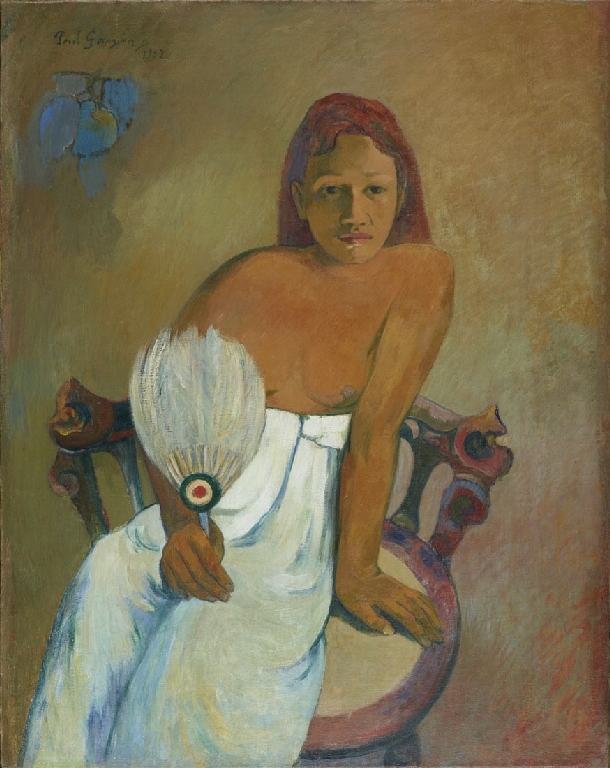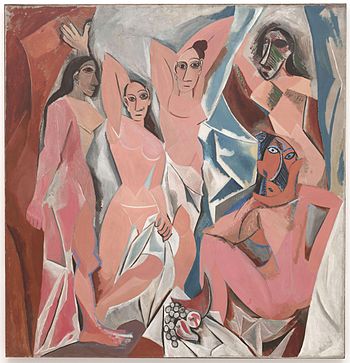LESSON 27: Globalization and the Global Art Market
Globalization: “is the process of world shrinkage, of distances getting shorter, things moving closer. It pertains to the increasing ease with which somebody on one side of the world can interact, to mutual benefit, with somebody on the other side of the world.” Thomas Larsson, The Race to the Top: The Real Story of Globalization (2001)

Picasso Les a’emoiselles d’avignon (1907)

Higher quality image http://www.moma.org/collection/works/79766
This has been re-balanced via popular culture in recent years:
Bollywood (Slumdog Millionaire 2009):
The numbers are certainly impressive – in terms of the number of films produced each year, Bollywood is firmly on top of the pile with 1,602 in 2012 alone. The U.S. churned out 476 films that year while the Chinese managed 745. In the same year, Hollywood sold 1.36 billion tickets compared to Bollywood’s shopping 2.6 billion. Indian films can’t match Hollywood in box office revenue, however. U.S. films grossed nearly $10.8 billion in 2012 compared to India’s meager $1.6 billion.
From here: http://www.forbes.com/sites/niallmccarthy/2014/09/03/bollywood-indias-film-industry-by-the-numbers-infographic/ (which also has an impressive Bollywood industry infographic)
Gangnam Style 2012 number 1 in more than 30 countries
Global Art World and Global Art Market
There are aspects of cultural influence going from West to East (or South) and vice versa (for example the artist Ai Weiwei, from China) though one of the biggest influences on the art global art world is financial profit, which will always benefit the wealthiest people and countries.
Art is considered one of the safest investment for the few super rich individuals who are still making large profits since the global financial crisis of 2008 (watch following film up to 7mins 58secs):
Art has become like investment. People gamble with it, and deliberately manipulate prices. This can affect what gets shown in museums:
So the global art market is in many senses directly linked to the global financial market. It mirrors globalization’s drive to profit. This situation is aided by the auction houses (such as Sotheby’s and Christies’) and large scale art fairs such as Frieze (London, New York), Artissima (Turin) and Art Basel (Basel and Miami).
However, it does also have a role in educating people abut different cultures and to promote debate on social and political issues within the art world. These roles are most closely associated with the Biennial and the museum space.
Biennials and Museums
Biennials and Museums tend to be at least in part publicly funded (by the government and local council via taxation) and as such have a responsibility to the public with money often being allocated by ‘arts councils’ (government arts bodies) to art projects that reach out to many people, are ‘inclusive’ and educate.
The unique history of the Biennial also leads to a situation where participants tend to use exhibition opportunities to discuss social issues relevant to the country they are from.
The first ever art biennial was the Biennale di Venezia, which started in 1895 as a celebration of the Silver Anniversary of Umberto I and Margherita di Savoia. From early on participations at the biennale have been broken up into national pavilions which were built by the wealthier countries of the early 20th Century in the ‘Giardini’.
The Biennale has a strong commerical aspect from early on and strong links to nation states, who often help to fund individual national participations. This leads to countries often exploring topical political issues, whilst at the same time wealthy gallerists and collectors often influence decisions about who will exhibit as it is simply too costly to produce works and ship them to Venice from around the world. The biennale did have a sales room from the 1940s to late 1960s.
As a result there is a mixture of public and private funding that is similar to the situation with museums which often have a strong element of private funding as well as public funding.
What are the relative merits of public and private funding? Discuss.
Last word on global art market from art critic Robert Hughes:
You must be logged in to post a comment.